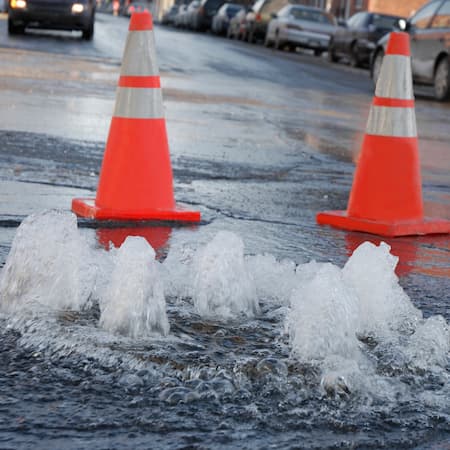Your Water In Crisis
Failing
infrastructure
In many cities and towns, the hidden network of pipes that bring safely treated water to your tap at home are leaking, breaking, and failing. What does this mean for freshwater resources?

The true cost of broken pipes
Failing water infrastructure in cities and towns goes beyond mounting costs for ratepayers. It poses significant risks to public health, safety, and freshwater resources. Common leaks and breaks, like the 1,400 annual watermain breaks in Toronto, if undetected or unaddressed, can lead to severe issues such as flooding and contamination of source waters.
Ever wonder how water gets to your tap?
If you live in a city or town, your local utility is likely treating millions of liters of freshwater every day to ensure that you have continuous service – that is, whenever you turn on your tap, there is safe, drinkable water waiting for you.


An underground network at risk
On its journey from the treatment plant to your home, treated water travels through a network of underground pipes (or "watermains") and pumps. The state of these pipes depends on many factors, including age, material, soil quality, corrosion, and seasonal fluctuations in temperature. There’s a separate network to collect and treat the wastewater that leaves your home, and the situation is similar: All of these systems need regular maintenance, and they’re all at risk of failing.
Untreated waters overflow into our source waters
Urban development strains water infrastructure. Rainwater naturally returns to lakes, streams, or the ground, but urban growth often leads to more paved surfaces. Stormwater sewers prevent street flooding, but leaks or breaks can release untreated stormwater into source waters. In cities with older systems, stormwater sewers connect to wastewater systems, and during heavy rainfall, the city has no choice but to discharge untreated sewage into source waters.


Solution spotlight
Tackling leaks and breaks
For many municipalities, monitoring the health of drinking water, wastewater, and stormwater infrastructure – much of which is underground – is a massive challenge. AquaHacking Challenge team CANN Forecast decided to help cities identify pipes that are vulnerable to leaks and breaks. Using AI technology, the team is offering InteliPipes, a system that is 10 times more accurate than traditional approaches to monitoring.
If a leaky pipe goes unnoticed and worsens, it could cause a dangerous sinkhole, contaminate the surrounding environment, or potentially flood homes or businesses. Our team wants to use AI to help municipal managers locate pipes that are vulnerable to leaks and breaks, and make informed, efficient decisions about when and how to repair, rehabilitate, or replace them.
NAYSAN SARAN
Co-Founder and CEO | CANN Forecast

We can still save freshwater
Join the ripple effect and do your part to protect freshwater from dangerous pollution. There’s still time!